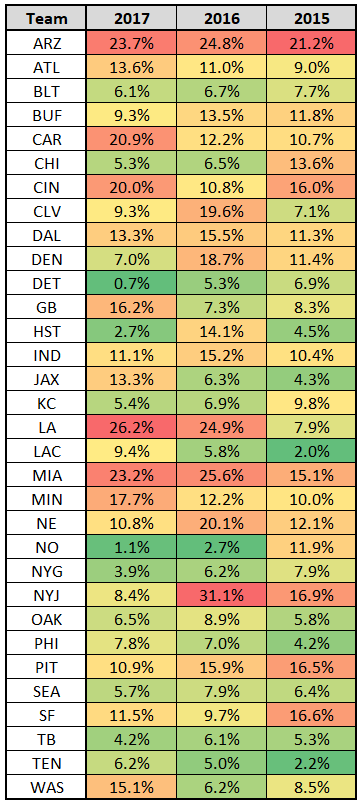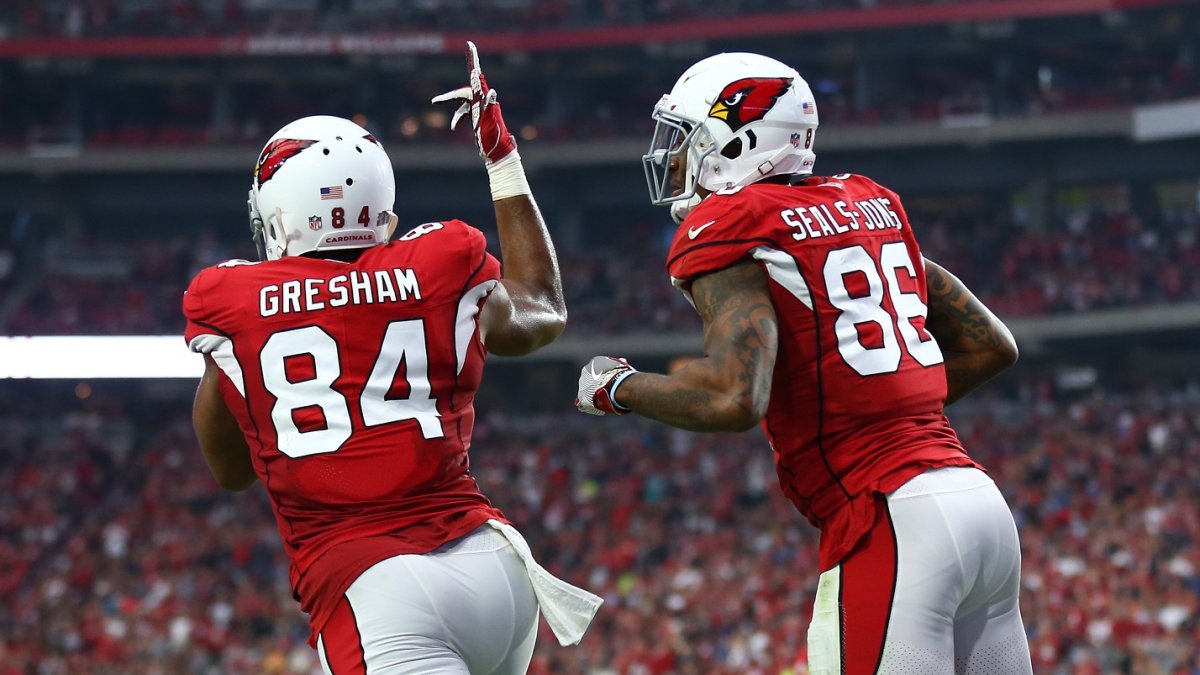(Metrics that Matter is a regular offseason feature that examines some aspect of fantasy through a microscope to dive into the finer details.)
One of the premium stats we offer to our Elite subscribers is the ability to measure how effective a tight end is at pass-blocking, via our pass-blocking efficiency metric.
For fantasy football, I don’t spend too much time worrying about whether my tight end is a good blocker. (In fact, I may even prefer that my fantasy tight end be bad at blocking.) Really, I just care about how often a tight end is blocking. You don’t get any fantasy points for a successful block, and each blocking attempt is a route that tight end isn’t running. Being asked to pass block more often (perhaps because you’re good at it) means fewer routes, fewer targets, and thus, fewer opportunities to score fantasy points. Luckily for us, the above link also tells us how often a tight end is asked to block, in contrast to how many routes they’re running.
Using this data, the below chart represents how often teams have asked their most-targeted tight end (in a given season) to block over the past three seasons, by measuring pass-blocking snaps as a percentage of total passing snaps.

Just to highlight the (albeit still somewhat small) significance, let’s look at Travis Kelce. Last season, Kelce ran 34.1 routes per game and pass-blocked only 1.9 times per game, for a pass-blocking rate of 5.4 percent. He also averaged 0.46 fantasy points per route run. If he pass-blocked an additional 10 percent of the time, it would have cost him 1.7 fantasy points per game.
Here’s who stood out
You’ll notice New England’s most-targeted tight end has ranked about average in pass-blocking frequency over the past three seasons. Although Rob Gronkowski is the best receiving tight end in the league (over the past three seasons, Gronkowski leads the next-closest tight end in yards per route run by a whopping 39 percent), he’s such a good blocker (he was our second-highest-graded pass-blocking tight end last season) that it might be eating into his fantasy potential. After losing left tackle Nate Solder in free agency, it’s possible Gronkowski is asked to pass block even more in 2018, but that’s not a fear I view as significant enough to impact my projections.
Last season, Green Bay’s Lance Kendricks pass-blocked on 16.2 percent of his passing plays, while Martellus Bennett wasn’t too far behind at 11.4 percent. That might be a concern for their newly signed tight end, Jimmy Graham (5.7 percent in 2017), but I’d bet Green Bay didn’t sign Graham to use him as a blocker. Graham ranked sixth-worst of 59 qualifying tight ends in pass blocking efficiency last season. Graham has also rarely ever been used as a pass-blocker throughout his career, pass-blocking on only 6.0 percent of his passing plays since entering the league. For perspective, only four other tight ends saw more than 50 targets and pass-blocked on less than 6.0 percent of their plays last season.
Ed Dickson signed with Seattle following Graham’s departure, but I don’t think it’s likely we see Dickson used in a similar manner to Graham. Dickson was our highest-graded pass-blocking tight end last season, has only eclipsed 50 targets once in eight seasons, and has pass blocked on 29 percent of his passing plays over the past three seasons.
Over the past three seasons, no team has asked their primary tight end to block as much as Bruce Arians’ Arizona Cardinals. Indeed, only the Jets targeted their tight ends less frequently over this span. With a new regime, and a new offensive identity (under offensive coordinator Mike McCoy), we might expect this trend change in 2018, however, the data suggests otherwise. In McCoy’s tenure as offensive play-caller (Denver 2009-2012, 2017), his TE1 has averaged only 48 targets per season, which is one of the lowest rates among all active play-callers. This implies an uphill battle for Ricky Seals-Jones, who impressed on a small sample (68 routes) last season, leading the position in yards per route run (2.96) as a rookie. Still, Seals-Jones was a wide receiver in college and wasn’t asked once to pass-block last season (a stark contrast to Jermaine Gresham’s talents) and could prove to be a valuable sleeper if Arizona is willing to commit to using him more.
Dating back to the start of the Jimmy Graham era, New Orleans has only twice asked their most-targeted tight end to pass-block on over five percent of their passing plays. Coby Fleener has pass-blocked only 2.2 percent of the time during his tenure with New Orleans, which makes his fantasy outputs all the more disappointing. Especially after courting Graham in free agency, I wouldn’t be shocked if New Orleans targeted a capable receiving tight end in this year’s draft.
Wherever free agent Eric Ebron lands, it’s unlikely to be with a team looking to utilize him as a pass-blocker. Ebron has pass-blocked on only 4.2 percent of his passing plays since entering the league. The lack of usage in this capacity likely underlines a lack of trust in his ability from the team, as does the fact that his pass-blocking rate has declined in each of the past three seasons. Ebron has also struggled as a run-blocker, grading out worst at the position two seasons ago. For similar reasons, there’s little risk sophomore tight end Evan Engram is likely to be used heavily in a pass-blocking capacity after the regime change in New York. He struggled mightily as a pass-blocker in college, was rarely asked to pass-block last season, and was also our third-worst-graded run-blocker last season.



 © 2025 PFF - all rights reserved.
© 2025 PFF - all rights reserved.